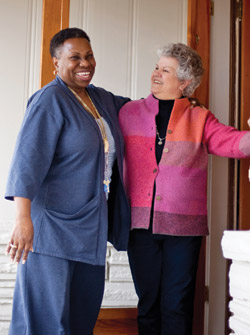Lymphoma Survivor
Fiercely Independent Survivor Learned to Rely on Others
 With the support of a small army of caregivers, Rhonda Holman beat non-Hodgkin lymphoma in 2008 and again in 2012. She currently works as a grant administrator for a health care foundation and lives with her cat, Horace. In her free time, Rhonda enjoys watching movies, doing crossword puzzles and traveling as money allows.
With the support of a small army of caregivers, Rhonda Holman beat non-Hodgkin lymphoma in 2008 and again in 2012. She currently works as a grant administrator for a health care foundation and lives with her cat, Horace. In her free time, Rhonda enjoys watching movies, doing crossword puzzles and traveling as money allows.
“If you’re going to have cancer, lymphoma is the one to have.” That’s what a friend told me in September 2008 when I was diagnosed at age 59 with follicular non-Hodgkin lymphoma with signs of possible transformation to diffuse large B-cell non-Hodgkin lymphoma. It’s also something that – several years and one relapse later – I’ve come to personally believe.
Because non-Hodgkin lymphoma is so common, it’s been the subject of a lot of worldwide research. There are many treatment options available today with new and improved treatments developing all the time, and I’m living proof that treatment can be successful.
A polyp biopsy from a routine colonoscopy led to my original diagnosis, which left me in disbelief. I didn’t feel sick, although in hindsight I realized that the lymph nodes beneath my jawbone and behind my ears had been enlarged for some time. I had also experienced daytime drowsiness that I now attribute to the lymphoma.
My initial treatment consisted of six chemotherapy treatments, each three weeks apart.
I tolerated the chemotherapy well, and I didn’t begin to feel the fatigue that I’d heard so much about until after my fourth treatment. I missed only one day of work other than the days needed for treatment, and I never suffered from nausea. Losing my hair wasn’t too big of a deal, either, because I expected it. Plus, it was during winter, when wearing a head covering was welcomed.
My relapse was diagnosed in December 2012. This time, my treatment consisted of an autologous stem cell reinfusion, which demanded a lot more of me physically and emotionally. If my initial chemotherapy treatment was four on a scale of one to 10, my stem cell reinfusion program was a 10. The medication that I received prior to the procedure took a very heavy physical toll. I was unable to eat because I couldn’t swallow. My sinuses and bronchial tubes drained for days on end, and I had terrible diarrhea. I again lost my hair, and I developed lines of demarcation across my fingernails from the dead cells beneath.
The reinfusion process required me to go into semi-seclusion for about a month, during which time I required 24/7 companionship because of the risk of infection and other dangers inherent in stem cell reinfusions. Given my introversion and fierce independence, having to rely on others for meals, transportation, house cleaning, laundry, yard work, etc. didn’t come naturally. I needed so much support, though, so I readily turned to my friends for help.
I got to virtually marinate in tangible and intangible support and good will. At one point, I had a house full of nieces, grandnieces and grandnephews working on various projects around the house. There were also days when I’d look out my window and see a small army of my coworkers taking care of my yard work, and days when people I didn’t know showed up, mowed my lawn, and then left without saying a word. I learned later that a former coworker was paying them to mow as her form of support for me while I was in treatment.
In addition, my friend Elaine kept my distant family and friends up-to-date through a weekly email on how I was doing. These proved very helpful because neither she nor I had to tell and retell the same information dozens of times.
Approximately seven weeks following my Day Zero – the day my cleansed cells were reinfused – I was pretty much healed internally, and I returned to work about three weeks later. One of my biggest joys was getting the nod from my health care team to return to my restorative yoga class.
Fortunately, my health insurance covered a substantial number of my treatment bills, so I didn’t run into severe financial hardship. For me, the hardest part was accepting my dependency on my caregivers. This experience deepened my humility and taught me a great deal about the value of friends. No matter how things appear on the surface, we’re all in this together. When I retire, I’ll volunteer some of my time and energy to other lymphoma patients without the network of friends with which I’ve been blessed.
Our lives are all inextricably intertwined and include both good and bad things that we rarely “deserve.” However, even the bad things can be gifts in the long run if we choose to see life in all its richness. Though I was dealt a really crummy hand, many good things came from it — and I’m still in the game.


